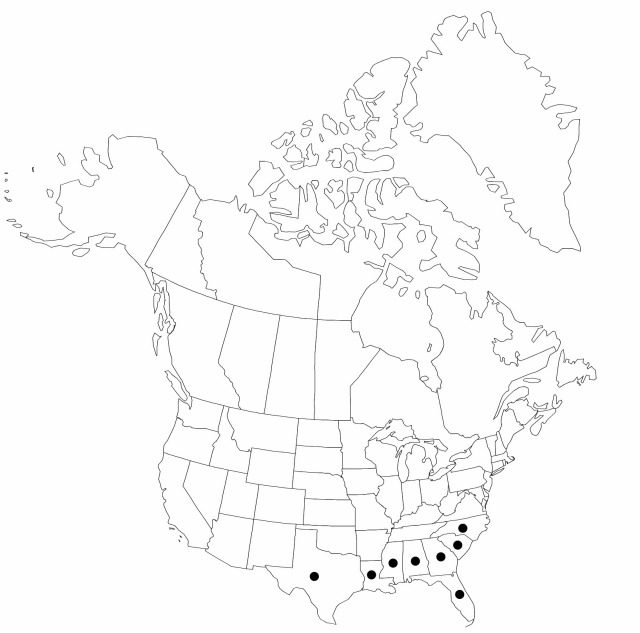Difference between revisions of "Rhynchospora globularis var. pinetorum"
Rhodora 46: 248. 1944.
FNA>Volume Importer |
imported>Volume Importer |
||
| (6 intermediate revisions by 2 users not shown) | |||
| Line 7: | Line 7: | ||
|year=1944 | |year=1944 | ||
}} | }} | ||
| − | |basionyms={{Treatment/ID/ | + | |special_status={{Treatment/ID/Special_status |
| + | |code=F | ||
| + | |label=Illustrated | ||
| + | }} | ||
| + | |basionyms={{Treatment/ID/Basionym | ||
|name=Rhynchospora pinetorum | |name=Rhynchospora pinetorum | ||
|authority=Britton & Small | |authority=Britton & Small | ||
| + | |rank=species | ||
| + | |publication_title=in J. K. Small, Man. S.E. Fl., | ||
| + | |publication_place=183, 1503. 1933 (as Rynchospora) | ||
}} | }} | ||
|synonyms= | |synonyms= | ||
| Line 26: | Line 33: | ||
|elevation=0–200 m | |elevation=0–200 m | ||
|distribution=Ala.;Fla.;Ga.;La.;Miss.;N.C.;S.C.;Tex.;West Indies (Antilles);Central America. | |distribution=Ala.;Fla.;Ga.;La.;Miss.;N.C.;S.C.;Tex.;West Indies (Antilles);Central America. | ||
| − | |discussion=<p>Rhynchospora globularis var. pinetorum frequently shares habitat with var. globularis in Georgia and northern Florida and, apart from a slightly taller and stiffer habit, and slightly longer and (sometimes) paler spikelets, var. pinetorum looks like var. globularis in the field. An inspection of fruit reveals significant differences. Of similar length, shape, and thickness, the fruit body of var. pinetorum has a distinct, shallow surface network of subisodiametric lattices nearly level with frame, or alveolae more sunken and frame more raised. While the tubercle of most plants of var. globularis is evenly conic, the slightly longer tubercle of those in var. pinetorum is concavesided and sharpertipped.</p> | + | |discussion=<p><i>Rhynchospora globularis </i>var.<i> pinetorum</i> frequently shares habitat with <i></i>var.<i> globularis</i> in Georgia and northern Florida and, apart from a slightly taller and stiffer habit, and slightly longer and (sometimes) paler spikelets, <i></i>var.<i> pinetorum</i> looks like <i></i>var.<i> globularis</i> in the field. An inspection of fruit reveals significant differences. Of similar length, shape, and thickness, the fruit body of <i></i>var.<i> pinetorum</i> has a distinct, shallow surface network of subisodiametric lattices nearly level with frame, or alveolae more sunken and frame more raised. While the tubercle of most plants of <i></i>var.<i> globularis</i> is evenly conic, the slightly longer tubercle of those in <i></i>var.<i> pinetorum</i> is concavesided and sharpertipped.</p> |
|tables= | |tables= | ||
|references= | |references= | ||
| Line 35: | Line 42: | ||
-->{{#Taxon: | -->{{#Taxon: | ||
name=Rhynchospora globularis var. pinetorum | name=Rhynchospora globularis var. pinetorum | ||
| − | |||
|authority=(Britton & Small) Gale | |authority=(Britton & Small) Gale | ||
|rank=variety | |rank=variety | ||
| Line 49: | Line 55: | ||
|publication title=Rhodora | |publication title=Rhodora | ||
|publication year=1944 | |publication year=1944 | ||
| − | |special status= | + | |special status=Illustrated |
| − | |source xml=https:// | + | |source xml=https://bitbucket.org/aafc-mbb/fna-data-curation/src/2e0870ddd59836b60bcf96646a41e87ea5a5943a/coarse_grained_fna_xml/V23/V23_401.xml |
|genus=Rhynchospora | |genus=Rhynchospora | ||
|species=Rhynchospora globularis | |species=Rhynchospora globularis | ||
Latest revision as of 21:40, 5 November 2020
Plants 30–80 cm. Culms arching, stiff or lax, slender. Spikelets dark to pale brown, broadly ovoid to ovoidlanceoloid, mostly 2–2.5 mm. Flowers: perianth bristles rarely reach 2/3 length of fruit body. Fruit body indistinctly crossridged, reticulate with broad, often isodiametric alveolae or lattices; tubercle depressed-conic to patelliform, apiculate, nearly as broad as truncate summit of fruit body.
Phenology: Fruiting spring–fall or all year (south).
Habitat: Sandy savannas, clearings in pine flatwoods, moist sandy swales, bog margins, ponds, lakeshores
Elevation: 0–200 m
Distribution

Ala., Fla., Ga., La., Miss., N.C., S.C., Tex., West Indies (Antilles), Central America.
Discussion
Rhynchospora globularis var. pinetorum frequently shares habitat with var. globularis in Georgia and northern Florida and, apart from a slightly taller and stiffer habit, and slightly longer and (sometimes) paler spikelets, var. pinetorum looks like var. globularis in the field. An inspection of fruit reveals significant differences. Of similar length, shape, and thickness, the fruit body of var. pinetorum has a distinct, shallow surface network of subisodiametric lattices nearly level with frame, or alveolae more sunken and frame more raised. While the tubercle of most plants of var. globularis is evenly conic, the slightly longer tubercle of those in var. pinetorum is concavesided and sharpertipped.
Selected References
None.
